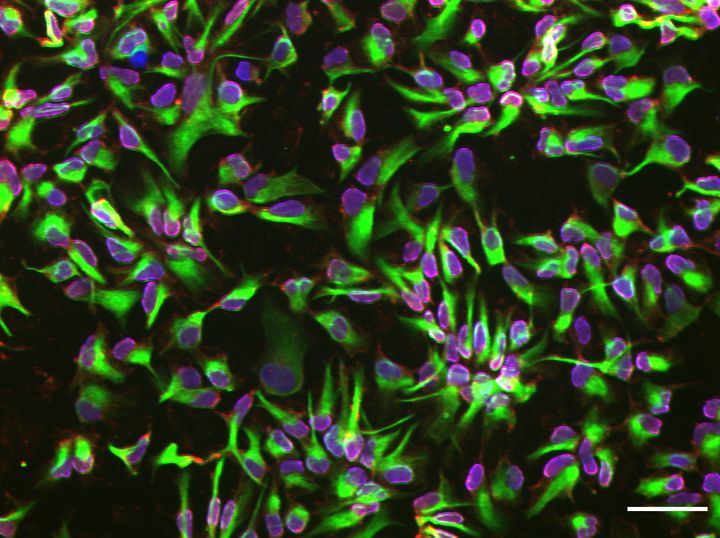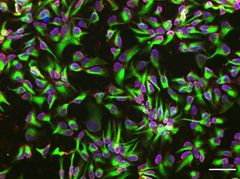Device improves stem cell generation and chance for accessible Alzheimer’s cell therapy
Researchers in Sweden say they have improved on a technique for converting regular skin cells into neural stem cells—an advance which they say helps close the gap for accessible personalized cell-based therapies for Alzheimer's and Parkinson's.

Using a specially-designed microfluidic device, the research team have developed an unprecedented and speedier approach to reprogramming human skin cells into induced pluripotent stem cells (iPSCs), and further transforming them into neural stem cells.
The study’s first author, Saumey Jain, says the platform could improve and lower the cost of cell therapy, making cells easier to match and be accepted by a patient’s body. The research was reported in Advanced Science by researchers from KTH Royal Institute of Technology.
Anna Herland, the senior author of the study, says the study demonstrated the first-ever case of microfluidics being used to redirect iPSCs toward becoming neural stem cells.
Engineering the transformation from regular cells into neural stem cells is in effect a two-stage process. Using a process that involves exposing cells to biochemical cues, the cells are induced into pluripotent stem cells (iPSCs), which have the power to generate different cell types.
Then they are transferred to a culture medium that mimics the signaling cues and developmental processes involved in formation of the nervous system. This stage, called neural differentiation, redirects cells to commit to being neural stem cells.
The medium for this kind of lab work has been shifting from well plates to microfluidic devices for nearly a decade. Herland says the new platform represents an improvement of microfluidics for both stages, iPSC generation and neural stem cell differentiation.
Using cells from a human skin biopsy, they found that the microfluidic platform enabled a boosted commitment to their neural fate at an earlier point than those differentiated in a conventional well plate format.
“We documented that the confined environment of a microfluidic platform boosts neural stem cell generation commitment,” Herland says.
Jain says the microfluidic chip is easy to fabricate using polydimethylsiloxane (PDMS), and its microscale size offers substantial cost savings in terms of reagents and cellular input.
The platform can be easily modified to enable adaptability for differentiation into other cell types, he says. It can be automated, providing a closed system that ensures consistency and reliability in producing highly homogenous cell populations.
“This marks a step towards making personalized cell-based therapies for Alzheimer's and Parkinson's accessible.”
Contributing to the study were researchers from Karolinska Institutet and Lund University collaborating in the VINNOVA-funded consortium IndiCell.
Contacts
David CallahanInternational Public Information OfficerKTH Royal Institute of Technology
press@kth.seImages
Subscribe to releases from KTH Royal Institute of Technology
Subscribe to all the latest releases from KTH Royal Institute of Technology by registering your e-mail address below. You can unsubscribe at any time.
Latest releases from KTH Royal Institute of Technology
Study explains why new kinds of steel needed to build lead cooled reactors11.12.2025 14:23:59 CET | Press Release
Safer operation, better fuel efficiency and lower waste mark lead-cooled nuclear power as a potentially dramatic shift from the water-cooled nuclear stations the world has relied on since the mid 20th century. A recent Swedish study casts new light on how to avoid corrosion in the steel used to build these next-generation nuclear facilities.
Alternative to BPA passes toxicity and sustainability standards set by EU innovation guidelines4.12.2025 11:07:37 CET | Press Release
Polyester and a host of other plastic products could potentially be manufactured with non-toxic and sustainable BPA alternatives identified in a multidisciplinary study published today by researchers in Sweden.
Study shows potential for more affordable and efficient hydrogen gas production3.12.2025 15:29:35 CET | Press Release
A recent advance in the science of hydrogen fuel production could enable higher output and more sustainable production of this renewable energy source, researchers with Stockholm’s KTH Royal Institute of Technology report.
Calcium-sensitive switch designed to boost efficacy of cancer drugs24.11.2025 21:11:53 CET | Press Release
Cancer-fighting antibody drugs are designed to penetrate tumor cells and release a lethal payload deep within, but too often they don’t make it that far. A new study shows how this Trojan Horse strategy works better by exploiting calcium differences outside and inside cells.
Potential treatment may prevent brain damage in premature babies11.11.2025 11:10:46 CET | Press Release
A treatment that could protect premature babies from brain damage showed promise in a recent study in Sweden. Using a first-of-its-kind prenatal brain model created with human cells, researchers observed new details about the effects of cerebral hemorrhages on stem cells during premature birth. And they successfully tested an antidote that reduced the damage.
In our pressroom you can read all our latest releases, find our press contacts, images, documents and other relevant information about us.
Visit our pressroom

